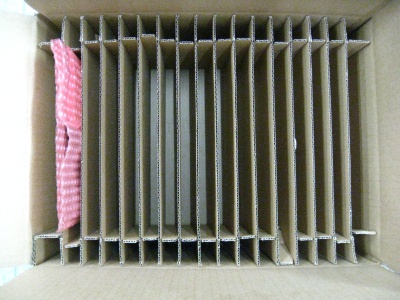Motherboard Handling Procedures
A laptop motherboard is easy to damage. This page contains recommended handling and storage processes.
Introduction
A modern printed circuit board (PCB), such as the motherboard in an XO laptop, is a very delicate object when removed from the laptop. It may be damaged by the slightest impact or electrostatic discharge (ESD). It is important that developers working with bare boards and repair facilities be aware of the proper handling and storage procedures for bare PCBs such as the XO motherboard.
Handling
When handling a bare motherboard, it is important to remember that the slightest impact may damage one of the tiny components on the motherboard.
General Guidelines
- Never place PCBs on top of one another without a buffer such as anti-static foam or bag.
- Always place PCBs on a soft, conductive surface.
- If an impact to the PCB happens (screwdriver slippage, drop, etc...) the area of impact should be examined under magnification, with components and PCB checked for cracking, chipping, or removal.
ESD
Electrostatic Discharge is one of the most common ways that a motherboard is damaged.
- Unless steps are taken to prevent it, ESD happens all the time,
- The damage it causes can cause degraded performance, as well as outright failure,
- The damage isn't always detectable immediately, it can cause failure weeks, or months later,
- There doesn't need to be a visible or audible spark for damage to occur.
A lot of testing and re-design goes into ensuring that the laptop case protects the motherboard from ESD. But once the laptop case is opened, or the motherboard removed from the case, the motherboard is unprotected. Due to the ability of ESD to damage most components on the board, in any number of ways that are hard to detect, it is important to always follow precautions to prevent ESD damage when working around bare motherboards.
A complete description of the steps taken to prevent ESD is to large to provide here, and can be obtained from the International Electrotechnical Commission (IEC) or American National Standards Institute (ANSI).
Simple steps which can be taken include:
- disassembling the laptop on top of a grounded conductive mat
- grounding the metal surfaces in a work space (NOTE: current limiting devices such as a 100K resistor should be in the ground path, to prevent accidental electrocution!)
- grounding oneself to a grounded metal surface or conductive mat before touching the motherboard
- when placing the motherboard on a surface, touch the surface with your hand before setting the motherboard down
- when passing motherboards from one person to another, touch each other before passing the motherboard
- placing motherboards inside conductive (anti-static) bags before transferring them out of a ESD protected workspace
- ensuring that the relative humidity in the work area stays above 30% RH (e.g. Humidity and ESD control).
If steps to prevent ESD are not taken, it is guaranteed that you will be invisibly damaging motherboards.
There is no cure once damage occurs. Prevention is the best cure.
There is no test to prove ESD damage has not happened. Prevention is the only practical act.
Storage and Shipping
When storing or shipping motherboards, it is important to:
- individually wrap each motherboard in an anti-static bag
- prevent the motherboards from colliding with each other, either by wrapping the anti-static bag in foam/bubble wrap or by using a box with cardboard dividers between each motherboard.
Our manufacturer, Quanta Computer, will not accept motherboards for repair or failure analysis if they have not been properly packaged and protected from ESD damage. The probability of unseen damage in shipping and handling is too high.
RTC Battery
If storing motherboards for longer than a month, it is recommended that the Real Time Clock battery be disconnected from the motherboard. Failure to do so may result in damage to the battery (through over-discharge) or the motherboard (though leakage and corrosion of the battery).
